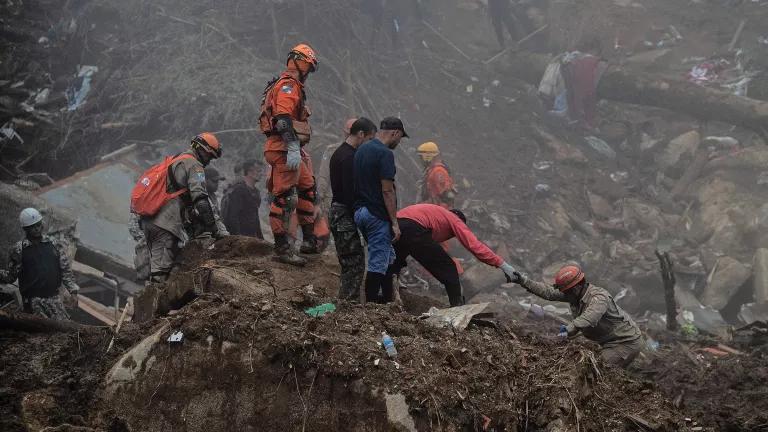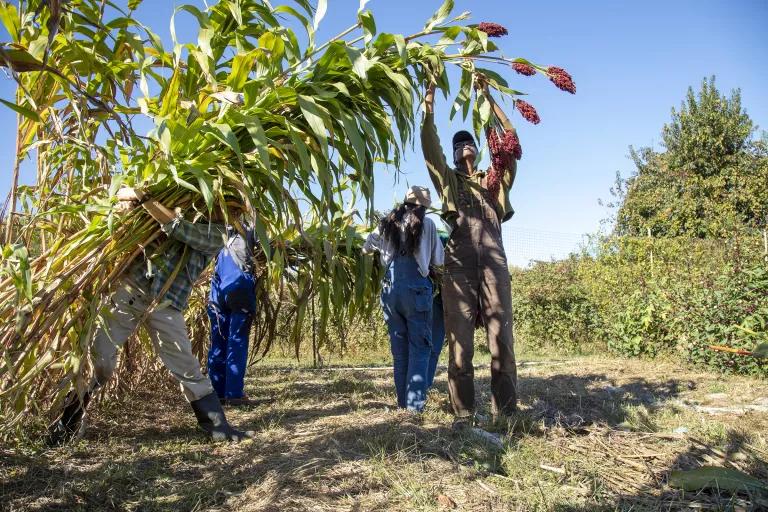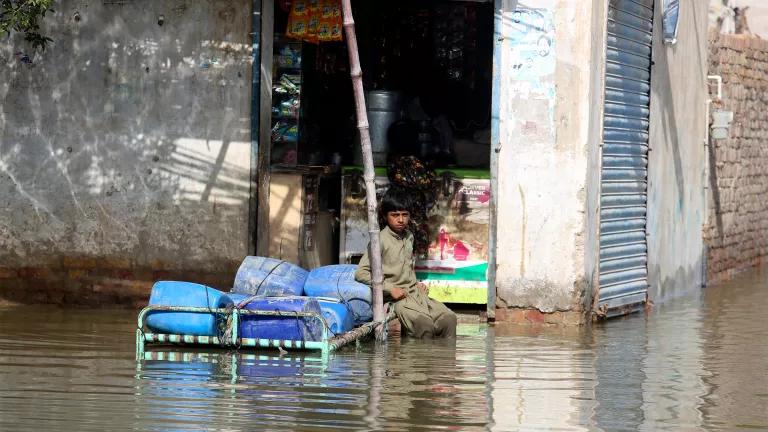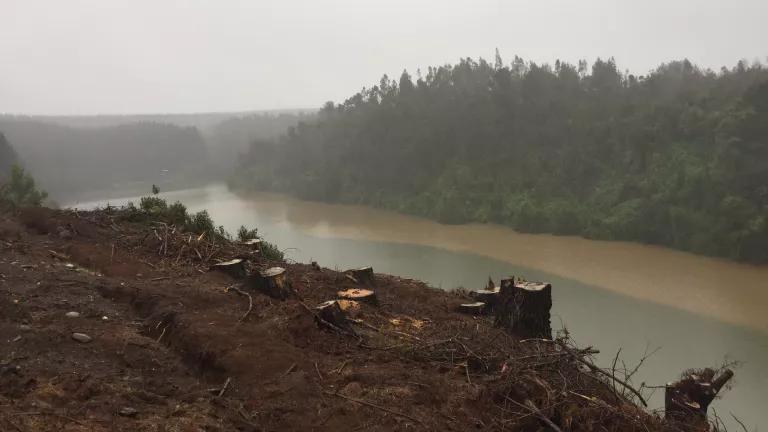We Can and Must Adapt to Climate Impacts Now
Climate impacts are here and getting worse—so we can and must adapt starting now.

Rescue workers at the scene of a giant landslide in Petropolis, Brazil, three days after a historic storm that left at least 122 dead and covered entire neighborhoods with mud, on February 18, 2022
Carl De Souza/AFP via Getty Images
In yet another clarion call to action, the leading scientific authority on all matters related to climate change has issued another urgent report. The message is simple: the world must act immediately to deal with unavoidable and compounding climate hazards. While it is “unequivocal that climate change has already disrupted human and natural systems,” the report urges that “societal choices and actions implemented in the next decade” will help determine just how resilient humanity will be.
From increasingly severe humanitarian crises to mass species extinctions, the warnings from the Intergovernmental Panel on Climate Change’s (IPCC) Sixth Assessment Working Group II report on impacts, adaptation and vulnerability are stark and jarring, although not entirely surprising. But the key takeaway is that we can and must take a wide range of climate actions available to us right now in order to deal with the climate crisis head-on.
Our best bet is to do so in a way that prioritizes communities and ecosystems that are bearing the worst impacts due to the effects of colonization and structural racism that influence climate vulnerability. To adapt as well as possible, this report echoes the IPCC’s 2018 Global Warming of 1.5℃ report, stating that long-term climate risks may require “extensive, transformative changes in our behavior and infrastructure,” and that “Half measures are no longer an option.”

Animals running into an engulfed Skyhawk Park as firefighters battle the Shady Fire in Santa Rosa, California, September 28, 2020
Kent Nishimura/Los Angeles Times via Getty Images
Widespread losses and damages to nature and people
The latest assessment is the starkest picture yet of a world beset by widespread and pervasive impacts of climate change. Millions of people around the world have already experienced food and water shortages. Extreme heat has increased illnesses and deaths in communities in every region of the world, but especially in the Global South, and caused some populations of species to disappear. Sectors such as forestry, tourism, and energy have suffered financial losses. And extreme weather and slower-onset climate hazards such as sea level rise are driving involuntary human migration, both within and across national borders.
This suffering is not felt evenly. The IPCC finds that Indigenous communities, people of color, people in the Global South, residents of small island nations, low-income people, and other communities already on the margins face the gravest and most concentrated risks. The climate vulnerabilities of communities like these will continue to deepen as the world warms unless the global community rallies to support them. The choice to protect the most vulnerable among us should be a moral imperative, but it’s also common sense. Ever-deepening and inequitable climate risks have implications for the viability of our global food system, the development of infectious disease pandemics, geopolitical stability, and more. Furthermore, as the IPCC found in 2018, it’s impossible to limit global warming to 1.5°C without addressing poverty and inequality.
Already, some natural systems and communities have run up against limits of responding to climate change. Some of those limits are “soft,” meaning adaptation options may exist, but aren’t currently available. Soft limits, such as a lack of financing, can be overcome with political will, international collaboration, and by tackling the root causes of wealth inequality. But other limits are “hard,” meaning that “no adaptive actions are possible to avoid intolerable risks.” Examples of hard limits include the collapse of fisheries dependent on coral reefs that are already experiencing unlivable heat. Our collective failure to drastically reduce the pollution causing climate change and urgently reduce our climate risks through adaptation will calcify many of the limits that are now soft into irreversible barriers to a livable and sustainable future.
Some decision-makers will use the world’s rapidly narrowing window of opportunity to justify approaches that ignore the social dimensions of the climate crisis. But that path is a fast track to “maladaptation,” according to the IPCC. Anything less than a systemic approach that integrates social dimensions will intensify inequality, lock in the vulnerability of those already suffering the most, and, ultimately, increase the difficulty and cost of future adaptive measures.

Seedkeeping apprentices Heidi Ratanavanich (front left) and Zainab Muhammad (front right) harvest sorghum at Truelove Seeds farm in Glen Mills, Pennsylvania, in October 2021. At Truelove Seeds, seeds are grown by more than 50 small-scale urban and rural farmers committed to community food sovereignty, cultural preservation, and sustainable agriculture.
Sahar Coston-Hardy for NRDC
Adaptation efforts must be accelerated to reduce climate risk
As the report states, the risks and impacts of the climate crisis can be reduced “if humans and nature adapt to the changing conditions.” We have already begun the hard task of adapting, but we can and must do a lot more. If there is good news to be heeded from the report, it’s that there are plenty of feasible and effective options we can take now to reduce risks to people and nature.
Here’s what some of that can look like in the United States:
- Although the Biden Administration has proposed the largest clean energy and environmental justice investments in U.S. history, it must keep leading and pushing for these changes, and Congress must be held accountable if they do not pass. This report underscores the urgency with which Congress must act. Every tenth of a degree of warming makes adaptation that much harder, but swiftly reducing emissions gives us more time to respond and makes success more likely.
- Governments at all levels need to factor climate risks into every major policy position they make—including what gets built where, how programs are structured and funded, and even how decision-makers organize themselves. This is a far cry from our current processes, which mostly ignore climate change until it literally knocks down someone’s door. NRDC’s recent work on federal agency climate adaptation plans, as well as advocating for bills that would establish a Chief Resilience Officer, illustrate the need to proactively build a culture of resilience.
- We know that the heat-related illnesses, infectious diseases, malnutrition, and other climate-related health consequences evident today will worsen. In addition to advocating for greater investment in basic public health infrastructure, we’re working to protect the health of workers who are on the frontlines, such as farm, meatpacking, and warehouse workers. To stay safe in a warming climate, workers need health-specific adaptation measures such as occupational heat safety standards. But they also need a more just and equitable economic system that provides a strong safety net and empowers workers to organize for healthier, safer lives.
- In addition, we recognize that more and more people will migrate across regions and countries at least partially due to climate impacts—the World Bank estimates up to 140 million by 2050 throughout parts of the Global South. The United States and other wealthier nations in the Global North need to take more proactive steps to prepare. In light of the historical contributions of greenhouse gas emissions by Western nations, it is their moral responsibility. Within the United States, we are pressuring lawmakers to update the National Flood Insurance Program to reduce harm to people and properties due to increased risk of flooding, and have asked the Federal Emergency Management Agency (FEMA) to update future flood maps to reflect how risks will change in the climate crisis.
- The report underscores the urgency to understand and work to reduce risks of climate impacts by centering the people and communities that are currently meeting the effects of the climate crisis head-on, calling out the need for drawing on Indigenous and local knowledge. This is a crucial component as we ramp up adaptation and resilience efforts across both urban and rural regions—to acknowledge that there are many forms of knowledge, to heed and elevate the voices of those most affected, and to collaborate respectfully and to keep building on this work based on trust.
- Further, we must understand that diverse and healthy ecosystems are fundamental to adaptation and building resilience. Just as “human and ecosystem vulnerability are interdependent” per the report summary, so too will be the solutions. For example, protecting old-growth forests in the Canadian boreal safeguards its biodiversity, helps maintain Indigenous ways of life, and helps keep carbon stored in its soil. We can and must work to figure out the co-benefits of adapting and building resilience—luckily, many of them are sensible and achievable.

A bird protecting its nest on the floor of the boreal forest in northwestern Ontario, Canada, June 2019
River Jordan for NRDC
We can step up—but we must do so now
In naming the breadth and the severity of present-day and future impacts, this report challenges lawmakers to provide urgent help to the people who need it most—and in doing so, reset the course of humanity and biodiversity for the near- and long-term. Rather than accepting the status quo that forecloses a stable future, we can and should create the liveable future we want. Keeping the pressure on Congress to make historic investments in the United States is the first step of many needed—to not only save lives, but to improve them.
This will not be easy, as it requires us to acknowledge and grieve the mounting losses, and at the same time, imagine and proactively create a more just and equitable world that will be able to withstand climate effects. But it’s entirely doable. By heeding the caution outlined in this report, we may be able to look back in 10 to 20 years and be reassured that we took action, in ways that truly mattered, when we did.



